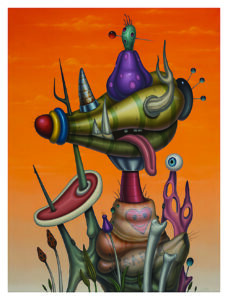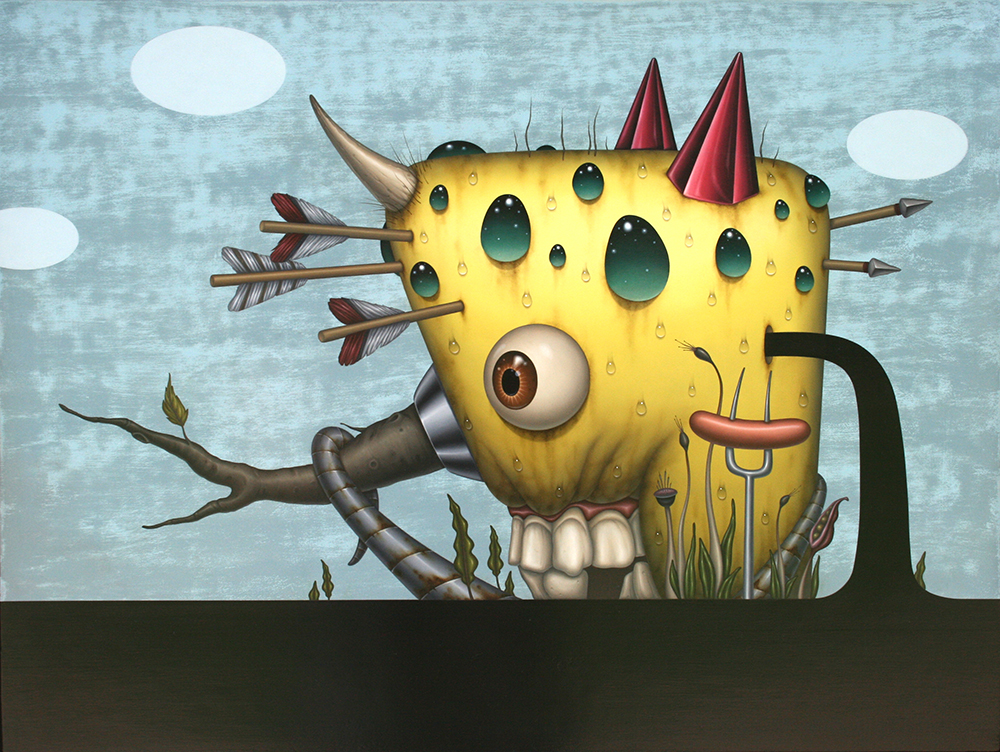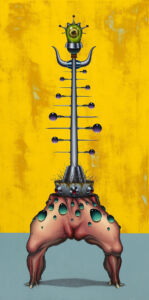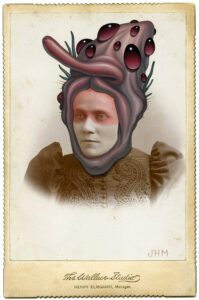“I am always keen to draw attention to the most major trend in contemporary art: Pop Surrealism. Justin Henry Miller is an artist who doesn’t mention that influence at all, but his weathervane is perfectly aligned with it,” remarks William Butler, an artist and the Executive Director of the Contemporary Art Center of Peoria.
Pop Surrealism originated as an underground movement within California’s subculture of graffiti, comics, tattoo, and punk music artists during the late 1960s. The obscure division between high and low-brow art sought a familial attachment to the discourse of Pop Surrealism. Today, contemporary artists have continued to explore this artistic realm.

‘Dreamsickle Skies & A Love Mound Surprise’ by Justin Henry Miller, 2021, oil on panel, 24×18 inches (orange background piece).
In his exhibition titled “Regards from the Black Hole,” Justin Henry Miller conjures a sense of enchantment and curiosity. As you step into the exhibition and ponder where to begin, you might question the intentions of his oil paintings. Do they depict fragments of sci-fi nightmares, sources of delight, or strike a delicate balance between the two? The subjects within his artworks blur the boundary between pleasure and fear.
With exquisite rendering, Miller skillfully combines a perversion of implied slick surfaces with indulgent colors, creating a sort of Freudian exploration of desires. Yet, within one’s visual vocabulary, a familiarity emerges as if these fundamentally different elements harmoniously converge.
Flanked on both sides of Miller’s peculiar paintings are a collection of vintage black and white photographs. The collages are embellished with meticulously hand-painted elements overlaid onto somber portraits, capturing an era when maintaining a smile for prolonged photographic exposures was a challenge. The artist’s ironic humor is revealed like an inside joke; unenthusiastic models grimace about their imposed appendages.
We talked last month.
Gronvold Roller: Justin Henry Miller, do you find that your artistic style aligns with the genre of Pop Surrealism, or do you have a different perspective on it?
Miller: “I definitely identify with the Pop Surrealist movement and the artists and aesthetics associated with it. I remember discovering publications like Juxtapoz Magazine and Hi-Fructose in college, and how inspiring it was for me to see artists blurring the lines between fine art, lowbrow, illustration, street art, graffiti, etc.
“Seeing the artwork of artists like Mark Ryden, Camille Rose Garcia, Jeff Soto, and many more, gave me confidence to pursue the content I was interested in. It has been rewarding to see this once marginalized movement become part of the greater art lexicon.”
Gronvold Roller: When examining your artwork, I notice a collection of organs, including those with sexual connotations, presenting a unique visual language of biological structures. Could you share your thoughts on what you hope viewers take away from the subjects in your paintings?

“Wannabe Satyr (FML)”, 2013, oil on canvas over panel, 18″ x 24″ (yellow head sinking into black bottom piece)
Miller: “I grew up on a horse farm, where I witnessed first-hand, man’s conscious manipulation of nature. Seeing my father perform artificial inseminations, ultrasounds, and inoculations on livestock proved to have a lasting impact.
“Out of this farm life exposure grew an interest in biological science and an increasing infatuation with the closing gap between science fiction and science fact. Cloning, transgenic breeding, surgical augmentation, and food modification are just a handful of supposed advances that have sparked my imagination. I approach my artwork imagining the experiments gone awry and try to create a work where the byproducts resist expiration. In a Frankenstein-like manner, characters are formed out of the detritus.
“While many of the forms that comprise the imagery in my paintings are from my imagination, they often trace back to my interest in didactic anatomical illustrations. I have always preferred the lush colors displayed in these recreations, over the true-to-life images of the body. My hope is that the details and chroma of my paintings draw viewers in, only to find they are in a complex.”
Gronvold Roller: Your proficiency in oil painting is truly impressive. Could you share the journey that led to your exceptional skill in this medium?
Miller: “I have been teaching painting for 15 years and I regularly talk to my students about ‘finding their hand’ as an artist. By this I mean, finding the technical mode best suited for your creative expression. The more I have painted, the more I have become enamored with the capabilities of oil paint.
“In graduate school I had the opportunity to study under Maria Tomasula, who remains one of the most masterful painters I know. She helped me understand the patience necessary to create paintings with a high level of technical resolve. Trips to Europe and seeing first-hand the works of artists from the Dutch Golden Age of painting helped reaffirm my infatuation with the visual payoff of intense detail and what viewers can only fully appreciate when they see the artwork in person.
“To further my knowledge of oil painting, I attended a workshop in 2017 at Anderson Ranch, taught by Christian Rex Van Minnen. This experience helped me better understand indirect methods of oil painting, like underpainting, grisaille, and glazing. My more recent work has become increasingly involved with these techniques.
“Even after painting for over 20 years, I still feel like I am learning something new with every painting I make, and that is part of what keeps me coming back for more.”
Throughout history, philosophers such as Plato, Aristotle, and Kant have explored concepts of beauty. Notable critics like Greenberg and Sontag have also contributed their perspectives, challenging conventional ideals of art aesthetics. When encountering “Regards from the Black Hole,” beauty becomes a provoking theme, prompting reflection, scrutiny, and perhaps, in the end, without a need to agree but to experience.
Justin Henry Miller is Head of Painting and Gallery Coordinator at SEMO in Missouri and represented by Zg Gallery in Chicago. His “Regards from the Black Hole” is on display at the Contemporary Art Center of Peoria through Dec 16.





1 comment for “Inland Art: Regarding the black hole”